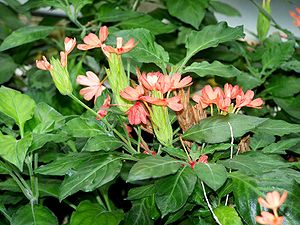Crossandra
| Crossandra | ||||||||||||
|---|---|---|---|---|---|---|---|---|---|---|---|---|

|
||||||||||||
| Systematics | ||||||||||||
|
||||||||||||
| Scientific name | ||||||||||||
| Crossandra | ||||||||||||
| Salisb. |
Crossandra is a genus of plants from the Acanthus family (Acanthaceae). The 50 to 52 species are common in the Paleotropic .
description
Vegetative characteristics
Crossandra species usually grow as upright shrubs or perennial herbaceous plants . The plants are bare or hairy.
The opposite or in whorls arranged and stalked leaves are simple. The leaf margins are smooth to more or less notched. Stipules are missing.
Generative characteristics
End or lateral, often over a long inflorescence stem, are the spiked inflorescences in which the flowers are close together. The most eye-catching, relatively large, ovate-lanceolate, overlapping bracts in four rows arranged (they are often referred to as bracts) have a smooth edge; their arrangement gives the inflorescence a square appearance in many species. The hairy, linear-lanceolate bracts have at most about the same length as the sepals.
The often large, conspicuous hermaphrodite flowers are five-fold and zygomorphic with a double flower envelope . The five unequal sepals are only fused at their base. The top calyx lobe is the widest and has two nerves. The five petals are fused with narrow tubes. The narrow, curved corolla tube is longer than the corolla lip and ends with a single lip. The only crown lip is clearly unequal five-lobed. The color of the petals ranges from white or yellow to orange to red. There is a ring-shaped disc. The four fertile stamens usually do not protrude from the corolla tube. The stamens are shorter than the anthers. The fringed anthers have only one theca . Two carpels are an above-permanent, two-chambered ovary grown with two ovules per ovary chamber. The stylus, which becomes thicker towards the top, ends in a weakly bilobed scar.
The elongated, double-faced, more or less square capsule fruits contain four seeds . The ellipsoidal egg-shaped seeds have fringed scales or hairs.
ecology
The seeds are ejected explosively from the capsule fruit. The unit of spread ( diaspore ) is the seed.
Systematics and distribution
The genus Crossandra was established in 1805 by Richard Anthony Salisbury in The Paradisus Londinensis sub , plate 12. The botanical genus name Crossandra is derived from the Greek words krossoi for fringes and andrós for man and refers to the fringed anthers. Synonyms for Crossandra Salisb. are: Harrachia Jacq. , Pleuroblepharis Baill. , Polythrix Nees , Strobilacanthus Griseb.
The Crossandra species are common in the Paleotropic : There are species in Africa , Madagascar (about 25 species), on the Arabian Peninsula and the Indian subcontinent .
The genus Crossandra belongs to the tribe Acantheae in the subfamily Acanthoideae.

Selected species
There are 50 to 52 accepted species in the genus Crossandra :
- Crossandra acutiloba Vollesen : It is only known from type material from the province of Toliara in Madagascar.
- Crossandra albolineata Benoist
- Crossandra armandii Benoist
- Crossandra benoistii Vollesen : This endemic is known from fewer than five localities in the province of Toliara in Madagascar.
- Crossandra cinnabarina Vollesen
- Crossandra cloiselii S. Moore
- Crossandra douillotii Benoist
- Crossandra flava hook.
- Crossandra flavicaulis Vollesen
- Crossandra fruticulosa Lindau
- Crossandra grandidieri (Baill.) Benoist
- Crossandra greenstockii S.Moore
- Crossandra horrida Vollesen
- Crossandra humbertii Benoist
- Crossandra infundibuliformis (L.) Nees (Syn .: Crossandra axillaris Nees ): It is native to India, Sri Lanka and Thailand. The number of chromosomes is 2n = 38 or 76.
- Crossandra isaloensis Vollesen
- Crossandra longehirsuta Vollesen
- Crossandra longipes S.Moore
- Crossandra longispica Benoist
- Crossandra massaica Mildbr.
- Crossandra mucronata Lindau
- Crossandra multidentata Vollesen
- Crossandra nilotica olive. : It occurs in tropical Africa. The number of chromosomes is 2n = 60.
- Crossandra nobilis Benoist
- Crossandra pilosa (Benoist) Vollesen
- Crossandra poissonii Benoist
- Crossandra puberula Klotzsch : It occurs in Tanzania, Malawi, Zambia, Mozambique and Zimbabwe.
- Crossandra pungens Lindau : The number of chromosomes is 2n = 42.
- Crossandra quadridentata Benoist
- Crossandra raripila Benoist
- Crossandra rupestris Benoist
- Crossandra spinescens Dunkley : It occurs in Zambia and Zimbabwe.
- Crossandra stenandrium (Nees) Lindau
- Crossandra strobilifera (Lam.) Benoist
- Crossandra tsingyensis Vollesen
- Crossandra vestita Benoist
- Crossandra zuluensis W.T.Vos & TJEdwards
swell
- Kamal Akhtar Malik, Abdul Ghafoor: Crossandra at Tropicos.org. In: Flora of Pakistan . Missouri Botanical Garden, St. Louis
- Lucinda A. McDade, Carrie Kiel: Entry in the Tree of Life project, 2006. (Eng.)
- Mark Hyde, Bart Wursten: Entry in the Flora of Zimbabwe , 2009. (Eng.)
Individual evidence
- ↑ a b c d e f g h i j k l Kamal Akhtar Malik, Abdul Ghafoor: Crossandra at Tropicos.org. In: Flora of Pakistan . Missouri Botanical Garden, St. Louis
- ↑ Crossandra at Tropicos.org. Missouri Botanical Garden, St. Louis, accessed on 2017-12-2.
- ↑ a b Crossandra at Tropicos.org. In: Catalog of the Vascular Plants of Madagascar . Missouri Botanical Garden, St. Louis
- ^ A b c d Crossandra in the Germplasm Resources Information Network (GRIN), USDA , ARS , National Genetic Resources Program. National Germplasm Resources Laboratory, Beltsville, Maryland. Retrieved December 24, 2017.
- ↑ a b c Crossandra at Tropicos.org. In: IPCN Chromosome Reports . Missouri Botanical Garden, St. Louis
Web links
- Crossandra at Tropicos.org. In: Flora de Nicaragua . Missouri Botanical Garden, St. Louis


